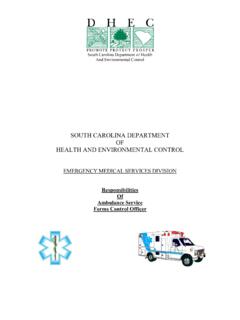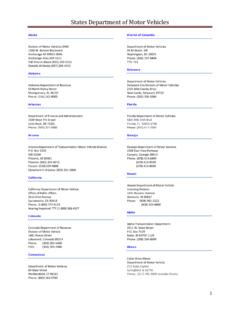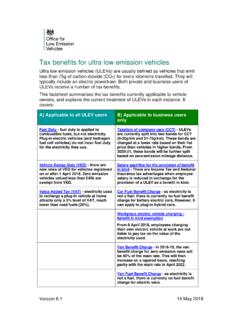Transcription of VEHICLE IMPORTATION GUIDELINES - NHTSA
1 VEHICLE IMPORTATION GUIDELINES (Imported from Canada) September 12, 2017 Importing a Canadian-Certified VEHICLE as a Conforming VEHICLE under Box 2B To be imported free of restriction, a motor VEHICLE less than 25 years old must be originally manufactured to comply with all applicable Federal motor VEHICLE safety standards (FMVSS) and bear a label certifying such compliance that is permanently affixed by the VEHICLE s original manufacturer. A motor VEHICLE that bears a label certifying compliance with all applicable Canadian motor VEHICLE safety standards (CMVSS), but not with the FMVSS, can still be imported as a conforming motor VEHICLE under Box 2B on the HS-7 Declaration form to be presented to Customs and Border Protection (Customs) at the time of entry if the following requirements are met: The VEHICLE is being imported for personal use and not for resale; The VEHICLE is not a salvage VEHICLE , a repaired salvage VEHICLE , or a reconstructed VEHICLE .
2 The importer obtains a letter from the VEHICLE s original manufacturer, on the manufacturer s letterhead (and not that of a franchised dealer), identifying the VEHICLE by VEHICLE identification number (VIN) and stating that the VEHICLE conforms to all applicable FMVSS except for the labeling requirements of Standards Nos. 101 Controls and Displays and 110 Tire Selection and Rims or 120 Tire Selection and Rims for Motor Vehicles other than Passenger Cars, and/or the specifications of Standard No. 108 Lamps, Reflective Devices, and Associated Equipment, relating to daytime running lamps. Note: To be imported under Box 2B a motor VEHICLE must be certified by its original manufacturer as complying with all applicable CMVSS.
3 Certain vehicles that are at least 15 years old that are not so certified can be imported into Canada without restriction. Such vehicles may not be imported into the United States under Box 2B. A list of manufacturer contacts is provided below for the purpose of obtaining a letter of conformity. If the manufacturer s letter states that the VEHICLE complies with all applicable FMVSS except for those pertaining to the speedometer or headlights, the VEHICLE can still be imported as a conforming motor VEHICLE under Box 2B. If the manufacturer s letter states that the VEHICLE complies with all applicable FMVSS but does not comply with the parts marking requirements of the Theft Prevention Standard at 49 CFR Part 541, the VEHICLE can only be imported as a conforming motor VEHICLE under Box 2B if the importer furnishes Customs with an invoice from a franchised dealer or other commercial entity showing that the required theft prevention markings have been applied to the VEHICLE .
4 If the manufacturer s letter states that the VEHICLE complies with all applicable FMVSS but does not comply with the requirements of FMVSS No. 138 Tire Pressure Monitoring Systems, the VEHICLE can only be imported as a conforming motor VEHICLE under Box 2B if the importer furnishes Customs with an invoice from a franchised dealer or authorized repair facility of the VEHICLE s original manufacturer showing that a tire pressure monitoring system identical to, and with the same part number(s) as the system the manufacturer installs on vehicles manufactured for sale in the United States has been installed on the VEHICLE for which entry is sought. If the manufacturer s letter states that the VEHICLE complies with all applicable FMVSS except for the automatic restraint requirements of FMVSS No.
5 208 Occupant Crash Protection, the VEHICLE cannot be imported as a conforming VEHICLE under Box 2B. If the manufacturer furnishes a letter of this kind , or refuses to furnish a letter at all, the VEHICLE could only be imported into the United States on a permanent basis under Box 3 on the HS-7 Declaration form, as detailed below. Please note that the manufacturer can, at its discretion, refuse to issue a letter stating that the VEHICLE complies with all applicable FMVSS, and that NHTSA is not in a position to influence the manufacturer in this regard or to issue such a letter on the manufacturer s behalf. Importing a Canadian-Certified VEHICLE under Box 3 A Canadian-certified VEHICLE less than 25 years old can be imported on a permanent basis under Box 3 on the HS-7 Declaration form, provided: The VEHICLE is not a salvage motor VEHICLE or a reconstructed motor VEHICLE .
6 The VEHICLE is imported by a registered importer (RI) or by a person who has a contract with an RI to modify the VEHICLE so that it complies with all applicable FMVSS following IMPORTATION . A list of RIs in active status with the agency can be found at A bond underwritten by a certificated surety in amount equivalent to 150 percent of the dutiable value of the VEHICLE is furnished to Customs at the time of IMPORTATION to ensure that the VEHICLE is either brought into conformity with all applicable FMVSS within 120 days from the date of entry or is exported from, or abandoned to, the United States. Before a VEHICLE can be imported under Box 3, NHTSA must also decide that the VEHICLE is eligible for IMPORTATION , based on its capability of being modified to conform to all applicable FMVSS.
7 The agency normally makes import eligibility decisions on a make, model, and model year basis. Because the requirements of the CMVSS closely parallel those of the FMVSS, rather than determining import eligibility on a make, model, and model year basis, NHTSA has issued blanket import eligibility decisions covering most Canadian-certified vehicles. However, because there are some dissimilarities between the CMVSS and FMVSS, a Canadian-certified VEHICLE manufactured after the date on which an FMVSS with differing requirements takes effect can only be imported under a blanket eligibility decision if the VEHICLE is originally manufactured to meet the standard. A chart identifying the particular FMVSS that must be met by Canadian-certified vehicles manufactured after specified production dates is set forth below.
8 Covered vehicles that do not comply with an identified FMVSS can only be lawfully imported if NHTSA has separately decided that they are eligible for IMPORTATION on a make, model, and model year basis. For example, Canadian-certified Smart Cars manufactured between September 1, 2002 and October 30, 2007 are not eligible for IMPORTATION under a blanket eligibility decision because they were not originally manufactured with an automatic restraint system that complies with the requirements of Standard No. 208 and/or they do not comply with one or more of the other specified standards. Such vehicles may nevertheless be eligible for IMPORTATION under the separate import eligibility decisions that NHTSA has made for particular model and model year Smart Cars.
9 The Environmental Protection Agency (EPA) also regulates the IMPORTATION of vehicles for compliance with the emissions standards administered by that agency. For further information on those requirements, you may call the EPA Imports Hotline at (734) 214-4100 or visit that agency s website at VEHICLES CERTIFIED BY THEIR ORIGINAL MANUFACTURER AS COMPLYING WITH ALL APPLICABLE CANADIAN MOTOR VEHICLE SAFETY STANDARDS Import Eligibility Number Descriptions of Eligible Vehicles Docket Number Online Not Online VSA-80 (a) All passenger cars less than 25 years old that were manufactured before September 1, 1989; 96-114 (b) All passenger cars manufactured on or after September 1, 1989, and before September 1, 1996, that, as originally manufactured, are equipped with an automatic restraint system that complies with Federal Motor VEHICLE Safety Standard (FMVSS) No.
10 208; 96-114 (c) All passenger cars manufactured on or after September 1, 1996, and before September 1, 2002, that, as originally manufactured, are equipped with an automatic restraint system that complies with FMVSS No. 208, and that comply with FMVSS No. 214; 96-114 (d) All passenger cars manufactured on or after September 1, 2002, and before September 1, 2007, that, as originally manufactured, are equipped with an automatic restraint system that complies with FMVSS No. 208, and that comply with FMVSS Nos. 201, 214, 225, and 401; NHTSA 2002-12937 (e) All passenger cars manufactured on or after September 1, 2007, and before September 1, 2008, that, as originally manufactured, comply with FMVSS Nos.










